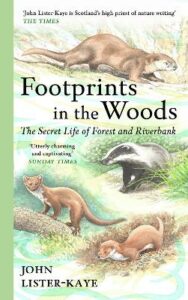‘In Footprints in the Woods, he writes at length about stillness. We can’t do anything about our scent, he says, but animals know that humans are loud and move about, so if we don’t act like that we can fool them into ignoring us.’
In his latest book, Footprints in the Woods, celebrated nature writer John Lister-Kaye takes the Mustelidae family as his focus, observing the comings and goings of otters, badgers, weasels and pine martens around his home at Aigas. In this exclusive interview, David Robinson speaks to the man dubbed ‘Scotland’s high priest of nature writing’.
Footprints in the Woods
By John Lister-Kaye
Published by Canongate
I first interviewed John Lister-Kaye 20 years ago for a feature in The Scotsman. Back then, not everything in print made it onto the internet, and as my interview didn’t, I’m relying entirely on memory to recall the afternoon he showed me round his conservation and field study centre at Aigas, near Beauly. And in my memory, it’s filed away as one of life’s golden days.
To understand why, I’d better explain a few things. First of all, I’m a townie by birth, background and (I suppose) inclination, embarrassingly ignorant about the natural world, and in almost every other way John Lister-Kaye’s antithesis. To take just one example, he’s inherited a baronetcy which goes all the way back to 1378, and I have not. To take another, he’s built up his eco-tourism business from nothing to something worth millions to the local economy and I have not. And when I met him, he’d already been a published writer for 30 years, lectured on the natural environment all over the world, held high office in practically all the relevant national organisations, and was just about to be awarded an OBE, whereas I … well, you get the picture.
Another thing: I have always liked mavericks, people who hoick themselves out of pre-ordained grooves and tread their own path. And JLK was and is a classic case – in his twenties, walking away from a management traineeship to work alongside naturalist and Ring of Bright Water author Gavin Maxwell, and in his thirties setting up the first field study centre in the Highlands in the face of considerable local and bureaucratic scepticism.
How he transformed a ruined 19th century Highland estate into a vibrant eco-tourism business was part of the story of Song of the Rolling Earth, the book I was interviewing him about 20 years ago. What readers mainly noticed about it was the lyricism of the writing and the love of the natural world which powered the whole enterprise. He could easily have written a bombastic book taking potshots at the planners who recommended he open a caravan park instead of a field study centre or the local minister who lambasted him for encouraging people to defile the Sabbath by looking at wildlife, but that would have been petty, and the dream on which Aigas was built was bigger than that.
But while I’m sure he answered all my journalistic questions about Aigas (these days it is visited by up to 7,000 schoolchildren from 162 Highland schools and up to 1,000 paying guests on a whole variety of courses run by the 26 staff), what made that day stick in my mind was everything about the estate that couldn’t be so easily measured. Walking with him through his woods to the Illicit Still, the cosy lochside hut where he writes. Listening as he told me which bird I could hear, which animals had passed by in the night, what they had eaten, where they were going, where they would sleep, which predators they feared most, and where and when he would expect to find them. The world – or at least his world – opened up and his book came to life in front of me.
Twenty years on, he is back with another book, and because it’s called Footprints in the Woods it made me think back to the first time we met. In the intervening years, you may have noticed, nature writing has spent a long time in the psychiatrist’s chair – any day, you almost expect to see a book about how a badger/blackbird/barn owl saved a writer’s sanity – but Lister-Kaye doesn’t do that here. This is pure, unadulterated, old-school nature writing at its best, the focus entirely on animals – to be specific, mustelids (weasels, otters, badgers and pine martens) – rather than the writer’s psyche.
‘We have all of them at Aigas,’ he says when I chat to him again, ‘though if we walked through our woods again your chance of seeing a weasel are virtually non-existent.’ What sparked his new book was one March day two years ago when, out of the corner of his eye, he caught a glimpse of something scurrying near a dry-stone dyke. He thought it was probably a weasel, but because it was lockdown and the field centre was shut, kept going back there to make sure, and to find its nest.
‘I went back for 17 days, all through the frost, rain and snow, sitting down for hours at a time before I saw it. You need to be able to be still for a long while to see many things in nature, and these days that’s increasingly rare. Going into one of our hides in the evening is a two-and-a-half-hour stint and you may see nothing at all for the first half hour or 40 minutes before the animals – pine martens, badgers – come in and start to feed and we have real difficulty getting people to sit still. It’s not just young people, it’s all ages. They’ll fidget, fiddle with their phones, change lenses on their cameras, and we try very hard – and as gently and politely as we can – to sit still and watch the wildlife in front of them.’
In Footprints in the Woods, he writes at length about stillness. We can’t do anything about our scent, he says, but animals know that humans are loud and move about, so if we don’t act like that we can fool them into ignoring us. To be perfectly still is a denial of self and requires people to be fully aware of their surroundings and merge into them in a way he can’t quite explain but clearly can do himself. As he writes: ‘Frolicking badger cubs and pine marten kits have blundered into my feet, birds have landed on me, deer have often grazed right up to me, weasels and stoats have busied about around me, brown hares have stumbled into me, red squirrels and wood mice have scuttled over me, and just once, in our own Aigas pinewood, a wildcat stalked silently past three feet away carrying a leveret in its jaws.’
He tells me another story about stillness, one that isn’t in the book. In 1969, he was shooting rabbits on Pabay, the island just off Broadford on Skye, in order to feed the wildlife menagerie Gavin Maxwell was assembling nearby, when he came across a fox in a snare with wire wrapped round its body so tightly he was unable to free it. ‘So I called Gavin, and he sat down within biting distance of this fox which was in great pain and talked to it in a low voice for probably six or seven minutes. Very slowly, he reached forward and – again, within biting distance – began to untangle the wire. The fox never turned on him, and never made any aggressive moves at all, so he could untangle the wire and the fox ran off. I’ve never forgotten that. He really did have remarkable rapport with animals and it’s not surprising that this gripped the public imagination when he wrote Ring of Bright Water.’
He denies that he has the same level of skills, but I’m not so sure. In Gods of the Morning, he wrote about Squawky, a pet rook he looked after at prep school in Somerset and gave away to a woman who worked in its kitchen. A full quarter of a century later, he was in the area and called in to see her. Astonishingly, Squawky was still alive, seemed to recognise him and flew over to his arm.
There’s a similar story in Footprints in the Woods, and it probably goes a long way towards explaining why, two years ago at the age of 75, he was quite happy to sit near that dry-stone wall for so many hours at a time waiting for the weasel to pop out. When, six decades ago, he was at boarding school, he found a weasel kit left alive after a badger had killed its siblings. He named it Wilba and raised it for weeks on end. Wilba slept in a box next to his pillow, lived in the pocket of his tweed jacket or inside his school desk, and was fed through a pipette on diluted milk and glucose till he was old enough to be released. A year later, he went back to that spot with his father. After they sat down and ate sandwiches, Wilba ran up to him, briefly sat on his knee and ran off again.
Debrett’s have John Lister-Kaye down as the eighth baronet in a family knighted back in Plantaganet England, and certainly the banqueting hall at Aigas is chock full of aristocratic ancestral portraits, but that’s just an accident of birth. Being the magus of mustelids, friend to Wilba and Squawky, and Scotland’s greatest living nature writer isn’t.
Footprints in the Woods: The Secret Life of Forest and Riverbank by John Lister-Kaye is published by Canongate, priced £16.99.
ALSO IN THIS ISSUE

 Rainy Day Edinburgh
Rainy Day Edinburgh
‘Scotland is notorious for its inclement weather and there are dozens of words to describe the weath …

 Magnaccioni
Magnaccioni
‘Food is my constant life adventure. Between lovers and within family, it is interplay, bonding, enj …













